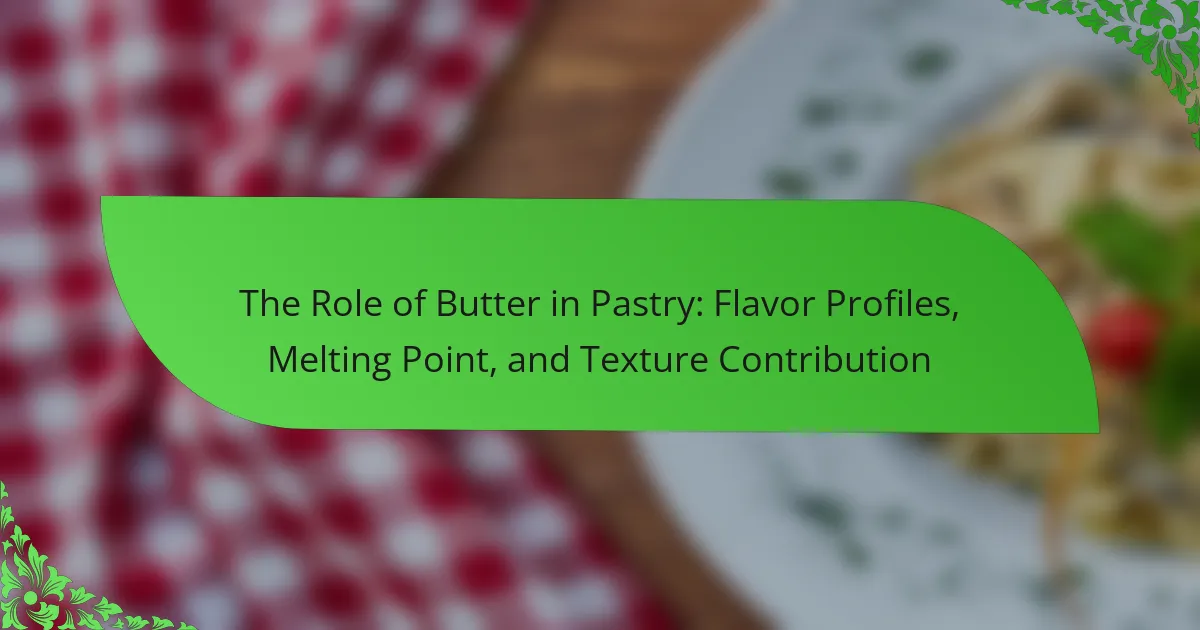Butter is a key ingredient in pastry-making, essential for enhancing flavor, moisture, and texture. It contributes richness and helps create a tender crumb by coating flour proteins, which reduces gluten formation, resulting in a lighter and flakier texture. The melting point of butter, approximately 90-95°F, facilitates the development of flaky layers, while its water content generates steam during baking, aiding in leavening and rise. This article explores the multifaceted role of butter in pastry, focusing on its flavor profiles, melting characteristics, and texture contributions.

What is the role of butter in pastry?
Butter plays a crucial role in pastry by providing flavor, moisture, and texture. It contributes richness and enhances the overall taste of the pastry. The fat in butter helps to create a tender crumb by coating flour proteins, which reduces gluten formation. This results in a lighter and flakier texture. Additionally, butter has a melting point around 90-95°F, which helps in achieving the desired flaky layers in pastries. The water content in butter also creates steam during baking, contributing to leavening and a desirable rise. These attributes make butter an essential ingredient in pastry-making.
How does butter contribute to flavor profiles in pastry?
Butter enhances flavor profiles in pastry through its rich, creamy taste. It provides a depth of flavor that complements sweet and savory ingredients. The fat content in butter carries and amplifies flavors during baking. This results in a more pronounced taste experience. Additionally, butter contributes to the Maillard reaction, creating complex flavors when pastries are baked. The browning effect adds nuttiness and richness to the final product. The unique flavor compounds in butter, such as butyric acid, further enhance its contribution. Overall, butter is essential for achieving desirable flavor profiles in various pastries.
What specific flavors does butter impart to different types of pastry?
Butter imparts rich, creamy, and slightly nutty flavors to pastries. In puff pastry, it enhances flakiness and adds a buttery taste. For shortcrust pastry, butter provides a tender texture and a rich flavor. In choux pastry, the butter contributes to a light, airy quality while maintaining a subtle richness. Danish pastry benefits from butter’s sweet and creamy notes, creating a decadent flavor profile. Croissants showcase a pronounced buttery flavor due to the lamination process. Each type of pastry utilizes butter’s unique properties to enhance its specific flavor and texture.
How do the flavor profiles of butter vary by type (salted vs. unsalted)?
Salted butter has a distinct flavor profile due to the added salt, which enhances its taste. The salt content typically ranges from 1.5% to 2%. This addition creates a savory note, making salted butter ideal for spreading on bread or enhancing savory dishes. Unsalted butter, on the other hand, has a pure, creamy flavor without the influence of salt. It allows for more control over the seasoning in recipes, particularly in baking. Unsalted butter is often preferred in pastry making, as it provides a neutral base for flavors. The choice between salted and unsalted butter can significantly affect the overall taste of a dish, especially in pastries where precise flavor balance is crucial.
What is the significance of melting point in butter for pastry making?
The melting point of butter is significant in pastry making because it affects texture and flakiness. Butter typically melts between 90°F and 95°F (32°C to 35°C). This melting range allows for the release of steam, which creates layers in the pastry. When butter melts during baking, it contributes to the overall tenderness of the pastry. The right melting point ensures that the butter remains solid until the dough is handled. This solid state helps maintain a structure that results in a flaky texture. Pastries made with butter that melts too quickly may become greasy and dense. Therefore, understanding the melting point is crucial for achieving the desired pastry quality.
How does the melting point of butter affect pastry texture?
The melting point of butter significantly affects pastry texture. Butter typically melts between 90°F and 95°F (32°C to 35°C). When butter melts during baking, it creates steam, which helps leaven the pastry. This process contributes to a flaky texture by forming layers. If butter melts too quickly, it can lead to a denser pastry. Conversely, if the butter remains solid during mixing, it can create a tender crumb. The balance of melting point influences how the pastry rises and its overall mouthfeel. Properly managing the melting point leads to optimal pastry results.
What are the ideal melting points for different pastry types?
The ideal melting points for different pastry types vary. For puff pastry, the ideal melting point is around 32-35°C (90-95°F). This allows for proper layering and flakiness. For shortcrust pastry, the melting point is approximately 28-30°C (82-86°F). This helps create a tender texture. For choux pastry, the melting point is about 60°C (140°F). This higher temperature aids in steam production for puffing. These melting points are crucial for achieving the desired textures and structures in pastries.
How does butter influence the texture of pastry?
Butter influences the texture of pastry by creating a tender and flaky structure. The fat content in butter coats flour particles, reducing gluten formation. This results in a softer texture. When butter is incorporated into the dough, it creates layers that contribute to flakiness. The melting point of butter allows it to create steam during baking, which further enhances the texture. A study published in the Journal of Culinary Science & Technology shows that the use of butter significantly improves the mouthfeel of pastries. This evidence supports the role of butter in achieving desirable pastry textures.
What role does butter play in creating flakiness in pastry?
Butter creates flakiness in pastry by providing layers of fat that separate the dough. When butter is incorporated into the dough, it coats the flour particles. This process inhibits gluten formation, resulting in a tender texture. As the pastry bakes, the water in the butter creates steam. The steam expands, causing the layers to separate and puff up. This leads to a light and flaky structure. Research shows that a higher fat content enhances this effect, making pastries more desirable.
How does the incorporation method of butter affect the final texture?
The incorporation method of butter significantly affects the final texture of pastry. When butter is creamed with sugar, it creates air pockets, resulting in a light and fluffy texture. This method is ideal for cakes and cookies. Conversely, when butter is cut into flour, it leads to a flaky texture, suitable for pie crusts. This technique coats flour particles, limiting gluten formation. Additionally, melting butter and mixing it into dough can yield a denser texture, often seen in brownies. Each method alters the distribution of fat and moisture, impacting the overall mouthfeel. The choice of incorporation method is crucial for achieving desired pastry characteristics.
What are the interactions between butter and other ingredients in pastry?
Butter interacts with flour, sugar, and liquid ingredients in pastry to create texture and flavor. When mixed with flour, butter coats the flour particles, inhibiting gluten formation. This results in a tender pastry. The fat in butter also contributes to flakiness when layered with dough.
Incorporating sugar with butter creates a creamy texture, enhancing flavor and moisture. Sugar also aids in browning during baking. When combined with liquid ingredients, butter emulsifies, helping to bind the mixture.
The melting point of butter allows it to create steam in the pastry, contributing to leavening and a light texture. The interactions between butter and other ingredients are crucial for achieving the desired pastry characteristics.
How does butter interact with flour to affect dough consistency?
Butter interacts with flour by coating the flour particles, which affects dough consistency. This coating creates a barrier that limits gluten formation. When gluten development is reduced, the dough becomes tender and flaky. The fat in butter also adds moisture, contributing to a softer texture. Additionally, the melting point of butter influences the dough’s structure during baking. As the butter melts, it creates steam, which helps leaven the dough. Research indicates that a higher fat content results in a more tender pastry. This interaction is crucial for achieving the desired texture in baked goods.
What is the impact of butter on the leavening process in pastries?
Butter impacts the leavening process in pastries by providing moisture and fat. This moisture helps to create steam during baking, which contributes to the rise of the pastry. The fat in butter coats flour particles, inhibiting gluten formation. This results in a tender texture, allowing for a lighter and flakier pastry. Additionally, butter’s melting point plays a role in creating air pockets. These air pockets expand during baking, further aiding in leavening. Studies show that the right amount of butter can significantly enhance the overall texture and volume of pastries.
What tips can enhance the use of butter in pastry making?
Use cold butter for flakier pastry. Cold butter creates steam during baking, which helps layers separate. Cut butter into small pieces to ensure even distribution. This technique prevents large clumps that affect texture. Incorporate butter quickly to maintain its temperature. Overworking the dough can lead to tough pastry. Use a pastry cutter or food processor for efficiency. This method reduces heat transfer from hands. Experiment with different butter types for varied flavors. European butters have higher fat content, enhancing richness. Consider adding a pinch of salt to enhance flavor. Salt balances sweetness and elevates overall taste.
How can temperature control improve butter incorporation in pastry?
Temperature control improves butter incorporation in pastry by ensuring optimal mixing and texture. When butter is at the right temperature, it blends more easily with flour. This creates a uniform dough without clumping. Proper temperature also prevents butter from melting too quickly. If butter melts, it can lead to a greasy texture. Ideal temperatures for butter range between 60°F to 65°F. At these temperatures, the butter remains pliable but not liquid. This allows for better aeration during mixing, resulting in a flakier pastry. Studies show that proper temperature management enhances the final product’s structure and mouthfeel.
What are common mistakes to avoid when using butter in pastry recipes?
Using butter in pastry recipes requires attention to detail to avoid common mistakes. One mistake is using butter that is not at the right temperature. Cold butter can lead to tough pastries. Another mistake is not measuring butter accurately. Inaccurate measurements can alter the texture and flavor. Overmixing the dough is also a common error. This can result in a dense pastry instead of a flaky one. Additionally, not chilling the butter or dough can affect the final product. Proper chilling helps maintain the desired texture. Lastly, neglecting to incorporate butter evenly can lead to uneven baking. Each of these mistakes can significantly impact the quality of the pastry.
The main entity of this article is butter, specifically its role in pastry-making. The article explores how butter contributes to flavor profiles, texture, and the leavening process in various pastries. It discusses the significance of butter’s melting point, the impact of different butter types (salted vs. unsalted), and the interactions between butter and other ingredients. Additionally, it provides tips for enhancing butter use in pastry, common mistakes to avoid, and the ideal incorporation methods to achieve desired pastry characteristics.
